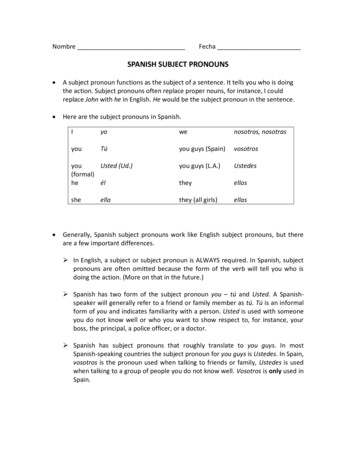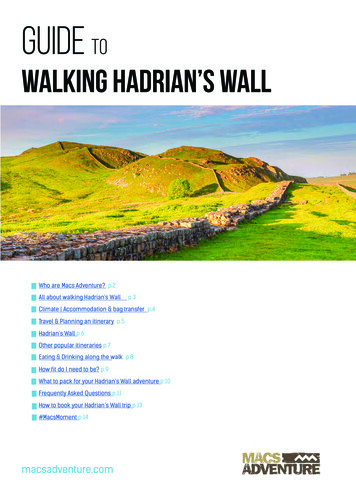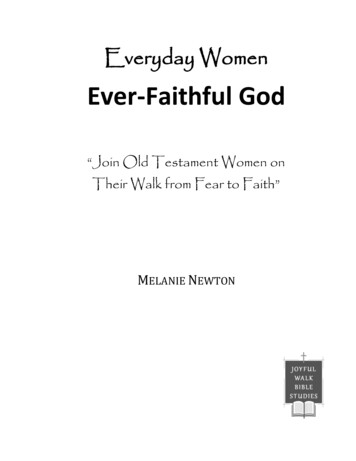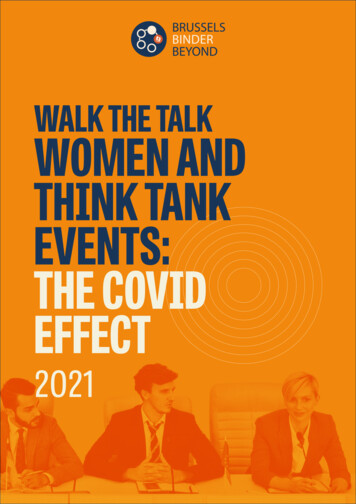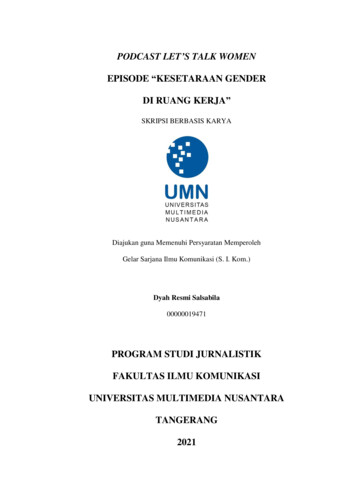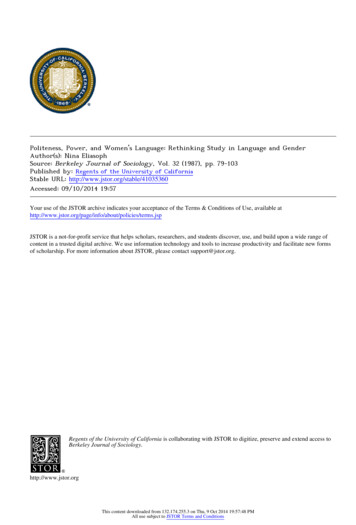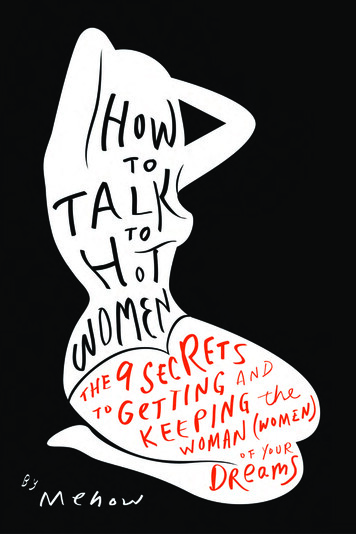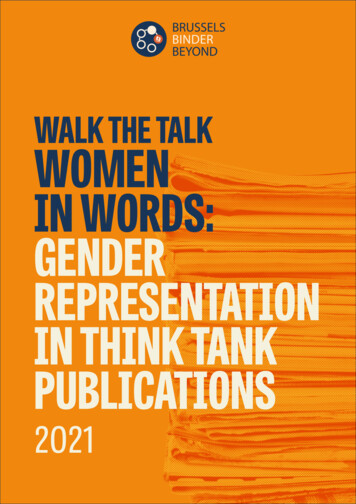
Transcription
WALK THE TALKWOMENIN WORDS:GENDERREPRESENTATIONIN THINK TANKPUBLICATIONS20211
The Brussels Binder BeyondMORE WOMEN’S VOICES IN EUROPEAN DEBATESSupported by the European Commission, Brussels Binder Beyond (BBBeyond) builtupon The Brussels Binder initiative with the idea to bring the efforts of The BrusselsBinder “Beyond” Brussels and across Europe.BBBeyond aimed to achieve the following objectives:1) build and cultivate a pan-European network of women expert databases, thinktanks, and like-minded organisations to raise awareness of the issue of underrepresentation of women and create synergies to promote women’s visibility;2) build and maintain an online repository of women expert databases; and3) co-create practical tools for diverse and innovative convening.By fostering an inclusive and solution-focused environment for knowledge transferand best practice exchange, BBBeyond has facilitated community-building activitiesthat focus on co-creation and peer-learning for the development of quality controltools and recommendations for diverse and innovative convening. As part of theproject, the BBBeyond network as notably inventoried women expert databases allover the world on an interactive map. We have also published six toolkits to supportorganisations and individuals in their diversity efforts.Head to www.brusselsbinder.org/bbbeyond to find out more about these tools.www.brusselsbinder.orgDATA COLLECTION:Annija Bertule, Conchi Mejias Carrascosa, Sabrine Dao, Eleonora del Vecchio, SophieDesmidt, Anastasia Pociumban, Harini Ravi.FINDINGS & ANALYSIS:Eleonora del Vecchio, Louise Langeby, Emma Rainey.CONCLUSIONS & RECOMMENDATIONS:Annija Bertule, Conchi Mejias Carrascosa, Sabrine Dao, Eleonora del Vecchio, EmmaRainey, Scarlett Varga, Anastasia Pociumban, Harini Ravi.CONSORTIUM:Bruegel, The German Marshall Fund of the United States, The Brussels BinderDISCLAIMER:The content of this deliverable represents the views of the author(s) only and is theirsole responsibility. The European Commission does not accept any responsibility foruse that may be made of the information it contains.The views expressed are those of the authors and do not necessarily reflect the viewsof their organisations.GRAPHIC DESIGN:Klär.graphicsThis project was funded by the European Union’s Rights,Equality and Citizenship Programme (2014-2020).2
TABLE OFCONTENTSACRONYMES & ABBREVIATIONSGLOSSARYEXECUTIVE SUMMARY4471. INTRODUCTION82. METHODOLOGY92.1. Think Tank Selection2.2. Limitations9103. FINDINGS & ANALYSIS113.1. General Findings3.2. Women in Research: Pipeline Issues?3.3. Gender Balance in Publications3.4. Publications During a Pandemic4. CONCLUSIONS11131516184.1. Structural Barriers4.2. Limited Representation4.3. Covid-19’s Impact on Women Authorship5. RECOMMENDATIONS181818195.1. What Think Tanks Can Do5.2. What Researchers Can Do1923ANNEXES25I - List of Think TanksII - Tables (from which the diagrams are based)III - Resources and Further Reading3252628
ACRONYMES &ABBREVIATIONSBB: The Brussels BinderBBBeyond: Brussels Binder BeyondEC: European CommissionEU: European UnionD&I: Diversity & InclusionDE&I: Diversity, Equity & InclusionEU/FP/S: EU, Foreign Policy & SecurityG/HR: Gender and Human RightsLGBTQIA : Lesbian, Gay, Bisexual, Trans, Queer, Intersex, AsexualGLOSSARYDiversity: Differences in the values, attitudes, cultural perspective, beliefs, ethnicbackground, sexual orientation, gender identity, age, skills, knowledge, and lifeexperiences of each individual in any group of people.1Equity: Equity is described as fairness, sameness, and valuing diversity and inclusion.Gender Balance: Human resources and equal participation of women and men in allareas of work, projects or programmes. In this specific research project, we consideredgender-balanced events, panels with at least 40% women are present as speakers.Gender Bias: Prejudiced actions or thoughts based on the gender-based perceptionthat women are not equal to men in rights and dignity.2Gender Binarism: The classification of gender into two distinct, opposite forms ofmasculine and feminine, whether by social system or cultural belief. In this binarymodel, sex, gender, and sexuality may be assumed by default to align, with aspects ofone’s gender inherently linked to one’s genetic or gamete-based sex, or with one’s sexassigned at birth.Gender Blindness: Failure to recognise that the roles and responsibilities of women/girls and men/boys are ascribed to, or imposed upon, them in specific social, cultural,economic and political contexts.3Gender Equality: Equal rights, responsibilities and opportunities of women and menand girls and boys.1European Commission. (1998). 100 Words for Equality: A Glossary of Terms on Equality between Womenand Men.2 IPS-Inter Press Service (2010). Gender and Development Glossary. A Tool for Journalists and Writers.3 United Nations Statistics Division – UNSD. Global Gender Statistics Programme4
Gender Equity: Provision of fairness and justice in the distribution of benefits andresponsibilities between women and men. Though often used interchangeably,equality and equity are two very distinct concepts. While international human rightstreaties refer to ‘equality’, in other sectors the term ‘equity’ is often used. The term‘gender equity’ has sometimes been used in a way that perpetuates stereotypesabout women’s role in society, suggesting that women should be treated ‘fairly’ inaccordance with the roles that they carry out. This understanding risks perpetuatingunequal gender relations and solidifying gender stereotypes that are detrimental towomen. Therefore the term should be used with caution to ensure it is not masking areluctance to speak more openly about discrimination and inequality.4Gender Gap: Gap in any area between women and men in terms of their levels ofparticipation, access, rights, remuneration or benefits.5Gender Identity: Gender identity is the personal sense of one’s own gender. Gender identity can correlate with a person’s assigned gender at birth or can differ from it. Genderexpression typically reflects a person’s gender identity, but this is not always the case.Gender Mainstreaming: Gender mainstreaming is the (re)organisation, improvement,development and evaluation of policy processes, so that a gender equality perspectiveis incorporated into all policies at all levels and all stages, by the actors normallyinvolved in policymaking. Mainstreaming a gender perspective is the process ofassessing the implications for women and men of any planned action, includinglegislation, policies or programmes, in all areas and at all levels. It is a way to makewomen’s as well as men’s concerns and experiences an integral dimension of thedesign, implementation, monitoring and evaluation of policies and programmes in allpolitical, economic and societal spheres so that women and men benefit equally, andinequality is not perpetuated. The ultimate goal is to achieve gender equality.Gender Parity: Gender parity is a statistical measure that provides a numerical valueof woman-to-man or girl-to-boy ratio.Gender-Sensitive: Policies and programmes that take into account the particularitiespertaining to the lives of both women and men, while aiming to eliminate inequalitiesand promote gender equality, including an equal distribution of resources, thereforeaddressing and taking into account the gender dimension.6Gender Stereotypes: Preconceived ideas whereby females and males are arbitrarilyassigned characteristics and roles determined and limited by their sex.Glass-ceiling: A glass ceiling is a metaphor used to represent an invisible barrierthat prevents a given demographic (typically applied to women) from rising beyond acertain level in a hierarchy.Home-based work: Work carried out by a person in her or his home or in other premises of her or his choice, other than the workplace of the employer, for remuneration,which results in a product or a service as specified by the employer, irrespective ofwho provides the equipment, materials or other inputs used.Inclusion: Inclusion is about how well the contributions, presence and perspectives ofdifferent groups of people are valued and integrated into an environment. An environment where many different genders, races, nationalities, and sexual orientations andidentities are present but only the perspectives of certain groups are valued or carryany authority or influence, may be diverse, but not necessarily inclusive.74 Desprez-Bouanchaud, A., Doolaege, J., and Ruprecht, L. (1999). Guidelines on Gender-Neutral Language,Paris, Unesco, Paris. Available at 0mo.pdf , CEDAWCommittee (2010). General Recommendation No 28 on the core obligations of States parties under Article2 of the Convention on the Elimination of All Forms of Discrimination against Women5 European Commission (1998).6 EIGE. Glossary & Thesaurus. Gender Sensitive.7Bush, M., (2021). Why Is Diversity & Inclusion in the Workplace Important?. Available tant5
Institutional capacity for gender mainstreaming: Potential of an institution to deliverupon its gender mainstreaming commitments and the ability to identify and solveimplementation-related problems.Intersectionality: Analytical tool for studying, understanding and responding to theways in which sex and gender intersect with other personal characteristics/identities,i.e. racial or ethnic origin, religion or belief, disability, age, sexual orientation, genderidentity or other characteristics, and how these intersections contribute to uniqueexperiences of discrimination. It starts from the premise that people live multiple,layered identities derived from social relations, history and the operation of structuresof power. Intersectional analysis aims to reveal multiple identities, exposing thedifferent types of intersectional and multiple discrimination and disadvantage thatoccur as a consequence of the combination of identities and the intersection of sexand gender with other grounds.8Invisible barriers: Attitudes and the underlying traditional assumptions, norms andvalues that prevent women’s empowerment/full participation in society.Manel: A panel where only men are present as speakers.Misgendering: refer to someone, using a word, especially a pronoun or form of address,that does not correctly reflect the gender with which they identify. More in general,making assumptions on someone’s gender based on their gender expression.Non-Binary: Non-binary or genderqueer is an umbrella term for gender identitiesthat are neither male nor female — identities that are outside the gender binary.Non-binary identities can fall under the transgender umbrella, since many non-binarypeople identify with a gender that is different from their assigned gender.Organisational culture: Commonly accepted values and behaviours within an organisation, such as the hours that are worked, the jokes that are considered appropriateand the manner in which colleagues are addressed.9Pinkwashing: when a company or institutions adopt (or pretend to adopt) a positiveattitude towards women or LGBT identities in order to promote their brand or product.10Sex: refers to the biological differences between males and females, such as thegenitalia and genetic differences. People that do not fit into the binary approachmale-female are intersex.Sex-disaggregated statistics: Data collected and tabulated separately for women andmen allowing the measurement of differences between women and men in terms ofvarious social and economic dimensions and are one of the requirements to obtaininggender statistics.11Sexual Orientation: Each person’s capacity for profound emotional, affectional and/orsexual attraction to, and intimate and sexual relations with, individuals of a differentgender, the same gender or more than one gender.Transgender: Person who has a gender identity different to the gender assigned atbirth and who wishes to portray gender identity in a different way to the gender assigned at birth.8 Mediterranean Institute of Gender Studies (2009). Glossary of Gender-Related Terms. Available at: %20Justice.pdf9 European Institute for Gender Equality. (n.d.). Institutional Transformation: Gender Mainstreaming Toolkit.Available at: transformation-gender-mainstreaming-toolkit10 Collinsdictionary.com. 2021. Definition of pinkwashing Collins Dictionary. [online] Available 388/pinkwashing11 United Nations Statistics Division. Glossary on Gender Statistics – Global Gender StatisticsProgramme.6
EXECUTIVESUMMARYResearch plays a central role in shaping and influencing policy byproviding evidence-based insights into realities and contributing toproblem-solving. However, gender imbalance in research is anongoing systemic issue where the lack of women’s representationmeans that currently produced work skews to a dominantly maleperspective, meaning that half the population is poorly representedin research.As part of The Brussels Binder’s efforts to make policy-making and shaping moregender inclusive and equitable, we have carried out several research projects focusingon women’s representation in think tank events and publications. This report analyseson the latter by reviewing gender balance and authorship in research outputs (reports,blogs, commentaries, etc.) from 33 think tanks based in Europe during the full year of2020. As this project was mainly volunteer-led, the scope of the research was limitedto three policy areas.The key trend throughout the findings of this study was that women account for onethird of total research authors which carried through when disaggregating the data fordifferent categories. It was also discovered that from the 65.5% of co-authoredresearch outputs with one woman or more, delving deeper into the data showed thatgender imbalance prevailed.By using secondary sources, this research further examined structural factors thatare preventing women from participating in research, including talent pipeline issues.It was found that women are overrepresented in administrative and organisationalroles in think tanks while men still made up the majority of executive level leadership12.When examining specific policy areas which are known to be male-dominated fields,it was also found that gender stereotypes could be inhibiting women’s access andprogression into research.2020 was also a year where research became more important with a demand for analysisand proposals in response to the Covid-19 pandemic. Although women’s productivity inresearch faced challenges prior to the pandemic, the reinforcement of gender roles hadexacerbated existing gender inequalities to the point where there was an evident declinein women’s research production.13Several detailed recommendations are included in this report for both think tanks andindividual researchers. Those for think tanks focus not only on addressing structuralissues that prevent women from accessing and progressing in research careers,but also how think tanks can make their research content more innovative andoutcome-oriented by adopting tools such as gender analytics. Lastly, recommendations for researchers involve making conscious and habitual changes to make theirresearch more inclusive.12 Balfour, R., Horst, C., Husch, P., Shevchuk, S. and Del Vecchio, E. (2020). Absent Influencers?Women in European Think Tanks”, The German Marshall Fund of the United States. Available encers-women-european-think-tanks13 Vincent-Lamarre, P., Sugimoto, C.R, and Larivière, V. (2020). The decline of women’s research productionduring the coronavirus pandemic. Available at rus-pandemic7
1. INTRODUCTIONThe lack of representation of women across political and policyspheres has been an ongoing phenomenon for quite some time, andat The Brussels Binder, efforts have mainly focused on promotingwomen’s voices in policy debates.However, as policy discussions are often based on research, it is equally importantthat gender representation is also accounted for at this stage in policy development.Research is also an important function for most think tanks and the lack of women’spresence in these roles14 means that the produced research is currently skewed towards a male-perspective. Therefore, the gender imbalance in who gets to produceresearch should be a matter of concern for those interested in effective policy outcomes15.Although the underrepresentation of women in research is not a new phenomena, theCovid-19 pandemic has heightened the importance of the issue by raising awarenesson the need for gender-responsive policies in dealing with the crisis. For example, theEU found that out of 115 Covid-19 task forces across 87 countries, just 3.5% had genderparity16. Actions have recently been taken by the EU with its Framework Programmefor Research and Innovation (2021-2027) in an attempt to address gender imbalance inresearch projects. The new provisions set out a legal basis for gender equality by makingit a cross-cutting priority and also outlines how it can be achieved17. It is important tohighlight that key funds for the Horizon2020 and Horizon Europe programmes are withinthis framework which tends to be a popular source of funding for many think tanks.Like elsewhere, the pursuit for gender equality often requires holistic and crosssectoral approaches, but it also needs benchmarks to determine whether structuralmeasures are having a positive impact18. In an attempt to do the latter, The BrusselsBinder has examined research papers published by 33 major think tanks based inEurope to assess the gender balance of their authors. The scope of this paper coversthe full year of 2020 (January to December), and although there are two monthsdeemed “pre-pandemic” included in the data collected (January and February), severalinsights will pertain to trends experienced during the crisis.This study not only assesses the gender gap in think tank publications by discussingstructural barriers but it also provides a series of recommendations for think tanks andindividual researchers on how to help mitigate gender disparities and become moreinclusive as an institution. By revealing the trends in publications and overall researchproduction, this report does not seek to name and shame individual organisations.Instead, the mission is to show data, and encourage reflection and systemic changewithin the European think tank community with an evidence-based, solution-focusedand positive approach. This collective exercise should offer a better understanding ofthe scope and root causes of the problem, as well as contributing to making researchmore representative of society’s nuances.14 Balfour, R., Horst, C., Husch, P., Shevchuk, S. and Del Vecchio, E. (2020). “Absent Influencers? Women inEuropean Think Tanks”, The German Marshall Fund of the United States. Available ncers-women-european-think-tanks15 Rainey, E. (2021). “Think Tanks.Get a Gender Lens!”, The Brussels Binder. Available ender-lens-on/16 European Commission (2021). International Women’s Day 2021: COVID-19 pandemic is a major challengefor gender equality. Available at: /en/ip 21 101117 European Commission (n.d) Gender equality in research and innovation. Available ns-rights/gender-equality-research-and-innovation en18 Agarwal, A. (2019). “How Big Data Can Help Achieve Global Gender Equality”, Impakter. Available ality/8
2. METHODOLOGY2.1. Think Tank SelectionIn order to select a number of think tanks to analyze, we decided to use the Global GoTo Think Tank Index Report from the University of Pennsylvania, Think Tanks and CivilSocieties Program.Our methodology consisted of picking one think tank per EU member state, includingthe United Kingdom selecting the highest/top ranking ones in the list. The decisionto include the UK is justified by the fact that believed it was important to include theUK based on its historical importance within the think tank community and for itsties with the EU. An additional reason to include the UK is that some independentthink tanks might be supported financially by EU funding, and therefore, maintaininga relationship with the EU that will not expire with Brexit. The UK’s think tank selectedfor the research was the International Institute for Strategic Studies (IISS), however,we couldn’t receive feedback regarding some lacking data and therefore we decidedto delete it from the study. See more details at footnote n. 20.2.1.1. NATIONAL VS EUROPEAN THINK TANKSDuring our selection process, we realized that although some think tanks have theirlegal registration in an EU member state, their research focus is European rather thanlocal or regional. For this reason, we created a separate category named ‘EuropeanThink Tanks’, where we listed a number of institutions that endorse the BB, have aEuropean vision stated in their mission, but were also listed in the Global Go To ThinkTank Index Report. We believed it was important to include the ‘European’ think tanks— that endorse an initiative such as The Brussels Binder — also to see whether thoseinstitutions are consistent with the idea of creating a more diverse and inclusive environment in the policy arena. We included 21 National think tanks and 12 Europeanthink tanks. In some cases, even though the institutes were ranked in the Index, theirwork was not relevant for the purpose of this research.We reviewed and analysed information that was available on the websites of thinktanks and then verified it with the respective think tanks19. Those that did not havepublications listed on their website, were considered “inactive” during the researchedperiod20. We also did not include think tanks that were offering more philosophicalreflections rather than evidence-based analysis. Additionally, we also excluded thinktanks that focused on one specific topic21 as well as those with a partisan connection22.19 Think tanks who verified the data collected: Bruegel, Carnegie Europe, CEPS, Centre for European Reform(CER), Clingendael, Netherlands Institute of International Relations,Center for Social and EconomicResearch (CASE), ECIPE, Egmont Institute, European Centre for Development Policy Management(ECDPM), European Policy Center (EPC), EUROPEUM Institute for European Policy,Ecologic Institute,Danish Institute for International Studies (DIIS), (ICDS), Finnish Institute of International Affairs, Friendsof Europe, German Marshall Fund of the United States, Brussels Office, Istituto Affari Internazionali,International Centre for Defence and Security , Institute for International Political Studies (ISPI), LisbonCouncil, Slovak Foreign Policy Association (SFPA).20 Think tanks that were considered inactive during the research period: Centre for Liberal Strategies (CLS)(Bulgaria) , European Institute (Bulgaria), Institute for Market Economics (IME) (Bulgaria) , Institute ofPublic Affairs (Bulgaria), Institute for Security and International Studies (ISIS) (Bulgaria) , PRAXIS Centerfor Policy Studies (Estonia), Center for Security and, Defense Studies Foundation (CSDS) (Hungary),Latvian Institute of International Affairs (Latvia), Providus (Latvia), Centre for, Geopolitical Studies(Lithuania) , Eastern Europe Studies Center (EESC) (Lithuania), Lithuanian Free Market Institute (LFMI)(Lithuania), Institute for Public Policy (IPP) (Romania), International Institute for Strategic Studies (IISS)(we found publications for this think tank but names of the authors were not featured and not they werenot responsive to emails).21 Think tanks that were excluded because they focus on a specific topic: Transparency International (TI)(Germany) (advocacy organisation) and Ludwig von Mises Institute (Romania)22 Think tanks that were excluded because they are partisan: Konrad-Adenauer-Stiftung (KAS) (Germany)and Friedrich Ebert Foundation (FES) (Germany)9
2.1.2. PUBLICATION CATEGORIESUnder the scope of this research, we have selected all think tank publicationspublished in 2020. Think tank research has been categorized under two main outputtypes: ‘Publications’ and ‘Other’. The ‘Publications’ category includes policy papers,policy recommendations, research reports/research briefs, policy briefs, monographs,working papers, business cycle surveys, analytical reports, books, and journals.Meanwhile, blog posts, Op-eds are opinion pieces, comments and commentaries areclassified as ‘Other’.In our analysis, research outputs are further divided into three categories: ‘EU/Foreign Policy and Security’ includes all publications on EU member staterelations, foreign policy (EU & non-EU), Diplomatic relationships betweenstates (EU & non-EU), Covid-19’s impact on security, and papers that exploredisinformation as a threat to security. This category also includes publicationsthat touch upon defense-related topics such as NATO interventions, terrorism,military interventions, peace agreements and border control policies. ‘Economics & Trade’ includes all publications with a broad ‘economics’ theme— such as papers on international trade agreements, macro and fiscalperspectives, fiscal and monetary policy, economic indicators of a country (GDP,debt, etc.), the economic impact of climate change, and Covid-19’s impact onthe economy. However, we exclude publications about internal politics andgovernance in a country (such as elections and internal social policy). ‘Digital & Innovation’ includes research output on digital topics such as cybersecurity, technology innovation to combat climate change, digital rights, changesto digital policies, and digitalisation due to Covid-19.2.2. LimitationsAlthough we are aware of the multiplicity of gender identities, we used a binaryapproach and we only considered two genders: man and woman. To determinesomeone’s gender, we made assumptions by looking at their gender expression,e.g. online picture, name, title, or pronouns used in biographical descriptions. Weacknowledge potential discrepancies which could have arisen from assessment ofgender of any author included in our research due to lack of related public data. Whenencountering a non-binary person, we did not include them in the statistics.While developing the methodology of our research, we realised that althoughwe wanted to collect data on other diversities, e.g. racial/ethnic background, weencountered the inability to do so without making assumptions on someone’s ethnicidentity. We also recognise that diversity is represented by many different aspects wedidn’t capture, as we only focused on gender with a binary approach.Another limitation in our methodology is the unequal sample sizes between Nationalthink tanks and European think tanks. As stated earlier, our analysis includes 21National think tanks and 12 European think tanks. We see this as a limitation in makingcomparisons between the two groups, however our analysis is descriptive and is notintended to capture statistically significant differences between the two groups. Inessence, there are more National think tanks than European think tanks in general,so our sample is reflective of the current state of affairs in Europe. For this reason, weconsider the sample balanced enough to validate our conclusions, though not enoughto make statistically significant inferences.In terms of policy areas, the categories we selected can often blur as many thinktanks’ publications overlap policy areas and in each publication different topics mightbe covered. Therefore, the publications were categorised based on the qualitativeassessment by the research team itself or the self-definition done by the think tanksthemselves, not based on any quantitative methodology. We should also mentionthat this research project was mainly a volunteer effort and was produced under aconstricted timeframe. Therefore, several decisions had to be taken to limit the scopeof the research.10
3.FINDINGS &ANALYSIS3.1. General Findings12 European think tanks and 21 national think tanks were analysed to get a firstsnapshot of how present women are within think tank publications by reviewing thegender representation of think tank research outputs during the full year (Januaryto December) of 2020. We focused on three policy areas that are typically knownto be underrepresented by women but are also policy areas that tend to have aprominent position in most think tank programmes.A total of 2347 research outputs were found with publications representing 61.6% ofthe total, while the rest falls in the “other” category. Also from this total, 35.3% wereco-authored pieces while 64.4% were solo-authored. Further to this, 4309 authorswere found with men constituting 66.4% of them compared to just 33.5% who werewomen. From the co-authored “publications” and “other”, 65.5% of them were coauthored with one woman or more. However, from the 1512 solo-authored researchoutputs, women constituted only 30.5%.Gender of the authors of all research outputs analysed in 2020Authored by women66.47%33.53%0%20%40%60%80%Authored by men100%Authors from national think tanks represent almost three-quarters of the total sumand they also produced more research outputs than European think tanks during2020. Notably, during 2020, national think tanks also produced nearly 10% more soloauthored research outputs
1) build and cultivate a pan-European network of women expert databases, think tanks, and like-minded organisations to raise awareness of the issue of underrepre - sentation of women and create synergies to promote women's visibility; 2) build and maintain an online repository of women expert databases; and

